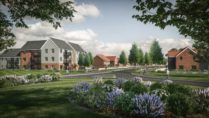November newsletter: political commentary
Economy
The October annual inflation rate was 6.7%, which was no change since September. It was  expected to fall but held higher by increasing fuel prices. It is expected to fall in November and the Government is on track to meet its target of halving the rate to 5.3% by the end of the year.
expected to fall but held higher by increasing fuel prices. It is expected to fall in November and the Government is on track to meet its target of halving the rate to 5.3% by the end of the year.
The Bank of England did not increase interest rates in October, the first freeze following 14 consecutive increases. The rate of 5.25% is expected to remain the same for the rest of this year.
Although the IMF predicts the UK will grow at the slowest rate of the G7 economies next year, there are signs of confidence returning and the country is unlikely to be at the bottom of the G7 table. The Bank of England has a difficult balance to achieve; ensuring inflation falls but not hiking interest rates so much that it triggers a recession. This is not made easier by the ‘lag’ experienced when interest rates change as they work through the economy.
Construction inflation is coming under control: there is some ‘slack’ emerging – councils are now getting five of six tenderers for construction projects as opposed to just one or two last year. This is encouraging as it increases competition putting downward pressure on tenders which will reduce prices, and so inflation. As the largest sector in the economy, this will have an impact.
Housebuilders are reporting falling sales rates, which is to be expected at times of high interest rates. There is not widespread pessimism about the medium of long term – far from it, strategic sites are currently coming forward faster than ever.
Politics
All the political parties have affirmed that they all need to build more houses, around the 300,000 a year target. Whereas the Conservatives have said they would protect the green belt, Labour seems to want to build on it, favouring more garden towns to deliver numbers at pace. Former PM Liz Truss has suggested 500,000 new homes per year is a better target.
The party conferences in October fired the starting gun for the General Election, although the decision as to when it will happen has yet to be decided. It all depends upon progress towards Sunak’s five priorities. There are three options: May 2024, autumn 2024 or January 2025. May could be too soon, January not the best option, which means the autumn is the favourite. Results of recent local elections also favour a later election.
Reforms
The Levelling Up and Regeneration Bill (LURB) received Royal Assent last week. Although it becomes law, many of the provisions will take some time to implement. The key elements include:
- The requirement to have design codes
- Replacement of S106 and CIL with a new Infrastructure Levy
- Infrastructure integral to the design and delivery of a site
- Local Plans to cover specific local elements, with other elements covered by National Development Management Policies
- The ‘duty to cooperate’ is dropped.
- Time limits for different stages of local plans
- EIAs replaced by ‘environmental outcomes reports’
- CPO to have ‘hope values’ removed in some instances
- Councils to consider previous build-out rates when deciding planning applications.
Reforms to the NPPF were promised in the spring, and then the summer, and then ‘later in the year’ after the LURB has gained Royal Assent. Possibly before Parliament rises for Christmas, but not a surprise if early in the new year.

Strategic land and site promotion
“Chelgate gives a real insight into political thinking at all levels and all political persuasions, …

Energy and infrastructure
From new nuclear and unconventional gas to renewables, waste and airports, our team has worked …

